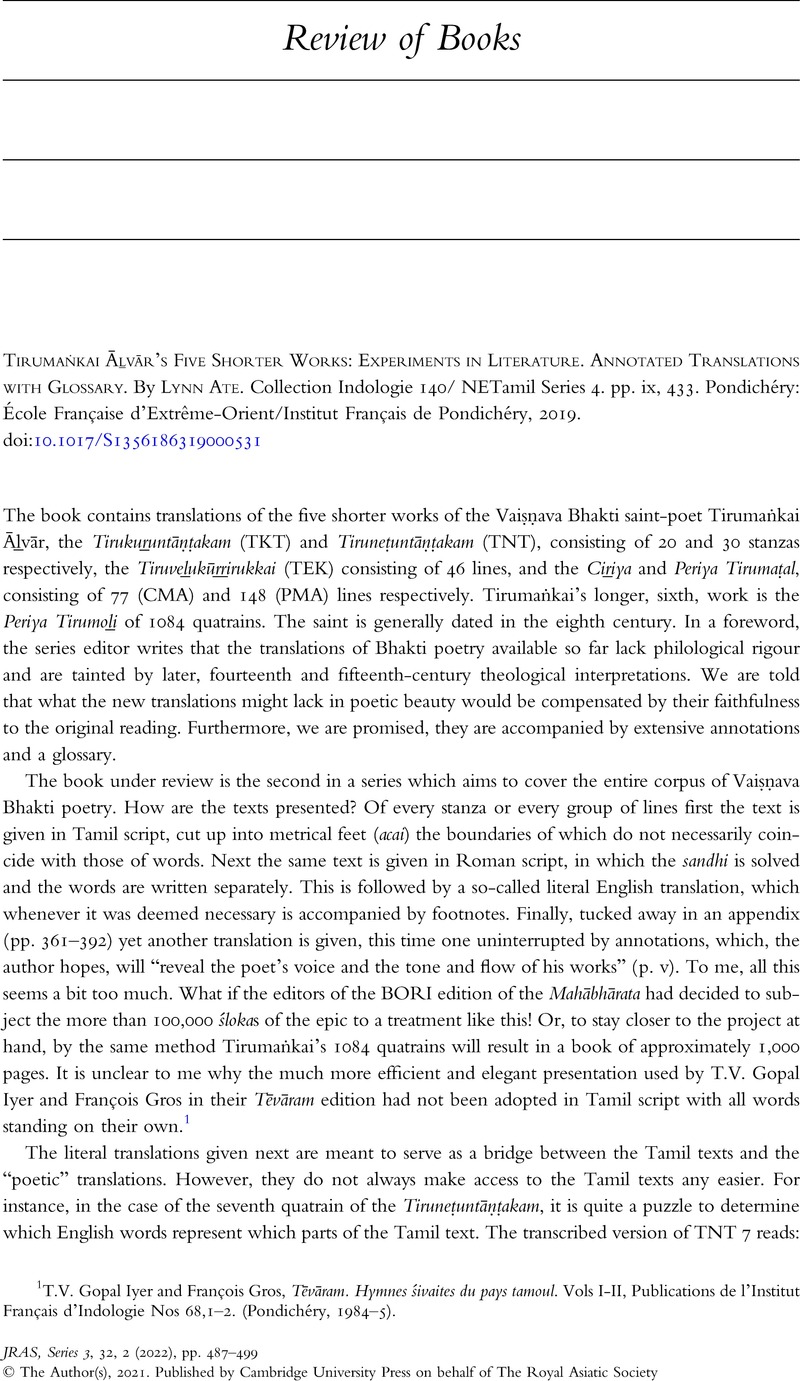No CrossRef data available.
Article contents
Tirumaṅkai Āḻvār's Five Shorter Works: Experiments in Literature. Annotated Translations with Glossary. By Lynn Ate. Collection Indologie 140/ NETamil Series 4. pp. ix, 433. Pondichéry: École Française d'Extrême-Orient/Institut Français de Pondichéry, 2019.
Published online by Cambridge University Press: 16 December 2021
Abstract

- Type
- Book Review
- Information
- Journal of the Royal Asiatic Society , Volume 32 , Special Issue 2: Divine Sovereignty, Morality and the State: Maududi and His Influence , April 2022 , pp. 487 - 493
- Copyright
- Copyright © The Author(s), 2021. Published by Cambridge University Press on behalf of The Royal Asiatic Society
References
1 T.V. Gopal Iyer and François Gros, Tēvāram. Hymnes śivaites du pays tamoul. Vols I-II, Publications de l'Institut Français d'Indologie Nos 68,1–2. (Pondichéry, 1984–5).
2 Pope, G. U., Tiruvāçagam or “Sacred Utterances” of the Tamil Poet, Saint, and Sage Māṇikka-vāçagar. (Oxford, 1900)Google Scholar, Jean Filliozat, Un texte de la réligion kaumāra. Le Tirumurukārruppaṭai. Publications de l'Institut Français d'Indologie No. 49. (Pondichéry, 1973), François Gros, Le Paripāṭal. Texte tamoul. Publications de l'Institut Français d'Indologie No. 35. (Pondichéry, 1968).
3 For kaṭṭurai- expressing indirect figurative speech, see below.
4 See Maas, Philip A., “’Sthirasukham Āsanam’: Posture and Performance in Classical Yoga and Beyond”. In: Baier, Karl, Maas, Philip A., Preisendanz, Karin (eds.) Yoga in Transformation: Historical and Contemporary Perspectives. (Vienna, 2018), pp. 51–100Google Scholar, especially p. 71, and Patrick Olivelle, Vāsudevāśrama Yatidharmaprakāśa: a treatise on world renunciation. Vienna 1976–1977, 66, 1–24, a section on yogapaṭṭavidhi. For photos of sculptural (Sanchi) and pictorial depictions of the yogapaṭṭa, see Seth Powell, “The Ancient Yoga Strap: A Brief History of the yogapaṭṭa” (https://www.theluminescent.org/2018/06/the-ancient-yoga-strap-yogapatta.html).
5 Tieken, Herman, “A Propos Three Recent Publications on the Question of the Dating of Old Tamil Caṅkam Poetry”. Asiatische Studien/Études Asiatiques LXII/2 (2008), p. 593Google Scholar.
6 See Andronov, M. S., The Kannaḍa Language. (Moscow, 1969), pp. 43–44Google Scholar.
7 Wilden refers to only one other study of aspect in Tamil, in case modern Tamil, by J. Deigner of 1998, titled Syntaktische Analyse von Verbalpartizip und Infinitiv im modernen Tamil. Unter Berücksichtigung synthetischer und analytischer Strukturen und des Verbalaspekts (Wiesbaden, 1998). In fact, the situation in Old Tamil is not different from that in Middle Indic, or literary Prākrit and Apabhraṃśa. Therefore, before embarking on a study of aspect in Old Tamil it might be useful first to consult the following two publications by Vit Bubeník: The Structure and Development of Middle Indo-Aryan Dialects (New Delhi, 1996) and A Historical Syntax of Late Middle Indo-Aryan (Apabhraṃśa), (Amsterdam, 1998).
8 See Tieken, Herman, Kāvya in South India. Old Tamil Caṅkam Poetry. (Groningen, 2001)CrossRefGoogle Scholar (reprint Delhi 2017). Note that what I say here applies to the Bhakti literary tradition, not the temple worship of Viṣṇu and Śiva.



